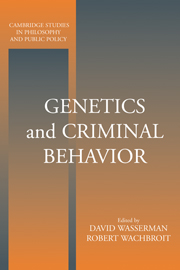Book contents
- Frontmatter
- Contents
- List of Contributors
- Acknowledgments
- 1 Introduction: Methods, Meanings, and Morals
- PART I
- PART II
- 8 Crime, Genes, and Responsibility
- 9 Genes, Statistics, and Desert
- 10 Genes, Electrotransmitters, and Free Will
- 11 Moral Responsibility without Free Will
- 12 Strong Genetic Influence and the New “Optimism”
- 13 Genetic Predispositions to Violent and Antisocial Behavior: Responsibility, Character, and Identity
- Index
9 - Genes, Statistics, and Desert
Published online by Cambridge University Press: 05 June 2012
- Frontmatter
- Contents
- List of Contributors
- Acknowledgments
- 1 Introduction: Methods, Meanings, and Morals
- PART I
- PART II
- 8 Crime, Genes, and Responsibility
- 9 Genes, Statistics, and Desert
- 10 Genes, Electrotransmitters, and Free Will
- 11 Moral Responsibility without Free Will
- 12 Strong Genetic Influence and the New “Optimism”
- 13 Genetic Predispositions to Violent and Antisocial Behavior: Responsibility, Character, and Identity
- Index
Summary
Suppose there is a population in which a certain type of criminal behavior is much more common than it is in most other populations that have been studied. To what extent can the relatively high frequency of that type of behavior in that population be ascribed to genetic, as opposed to environmental, factors? In the real world, this is always a very difficult question.
Let us suppose that – in some case, in respect of some type of behavior – this difficult question has been answered. Let us suppose that the high frequency of a certain type of criminal behavior in “population A” has been shown (to the satisfaction of all of the statisticians, criminologists, sociologists, and so on – of all political persuasions and ideologies – who have studied the matter) to be, to a significant degree, a product of genetic factors. Before investigating the consequences of this supposition for certain questions about punishment and desert, however, let us consider how such a conclusion could be established.
Suppose that, starting at a certain date, the babies born to parents belonging to population A and the babies born to parents belonging to a second population, population B – in which the incidence of the type of criminal behavior under investigation is significantly lower than it is in A – were exchanged in their cradles (the exchange being stealthy enough that the parents do not notice), the statistical profile of population A would, if no important changes occurred in the environmental conditions under which its members live, become significantly more like the present profile of population B after an appropriate amount of time had passed (and, of course, vice versa).
- Type
- Chapter
- Information
- Genetics and Criminal Behavior , pp. 225 - 242Publisher: Cambridge University PressPrint publication year: 2001
- 4
- Cited by



